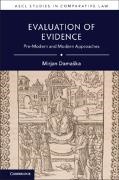Description
Product details
| Authors | Mirjan Damaka, Mirjan Damaska, Mirjan (Yale University Damaska, Mirjan Damaška |
| Publisher | Cambridge University Press ELT |
| Languages | English |
| Product format | Hardback |
| Released | 31.12.2018 |
| EAN | 9781108497282 |
| ISBN | 978-1-108-49728-2 |
| No. of pages | 160 |
| Series |
Ascl Studies in Comparative La ASCL Studies in Comparative Law ASCL Studies in Comparative Law Ascl Studies in Comparative La |
| Subjects |
Social sciences, law, business
> Law
> General, dictionaries
Rechtsvergleichung, LAW / Evidence, comparative law, Criminal Procedure: Law Of Evidence |
Customer reviews
No reviews have been written for this item yet. Write the first review and be helpful to other users when they decide on a purchase.
Write a review
Thumbs up or thumbs down? Write your own review.

